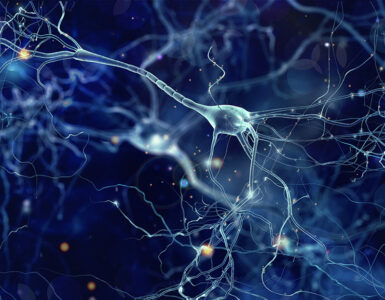by K. D. Williamson
Seven decades ago, neuroscientists and neurotechnology companies formed the NIP (Neural Interface Project) to lead the industry in rehabilitation. Bidirectional gray matter “chips” were implanted in the brain and programmed to solve an incredible range of issues which had plagued medical scientists worldwide for generations. The dream was always big, but the reality became bigger.
The earliest brain machines of the era could stimulate movement and read and communicate brain signals to assistive devices. The ambitions and pockets of entrepreneurs sent the tech rocketing forward. The new chips could bridge damaged neurons in epilepsy patients, sidestep impacted tissue in traumatic brain injury patients, improve emotion regulation, and inhibit unwanted sensations, perceptions, and behavior.
In the first five years, inpatient rehabilitation time for stroke and spinal cord injury patients halved. The next five years saw antidepressant and antipsychotic medications all but eliminated. The NIP was praised for scaling a mountain that we had skirted around for a century.
The NIP entered the prisons to conduct “voluntary” implants on “verified sociopaths.” The convicts received a commuted sentence under a contract for continual observation and implant renewal every 15 years, “until death do us part.” “Lifers” were reintegrated into society gradually, and the public began to accept that its safety was inviolable. Tax dollars were rerouted into infrastructure, education, and the NIP.
By 2055, the chip was coined “The Pacemaker for the Brain.” It became available to the general population at a modest fee of $6,500, marketed as “personal acceleration and augmentation.” Many jumped at the chance to get a leg up in life.
I took a pass thinking I might wait for the next upgrade or for insurance to pick it up. Still in my 40s at the time, in apparent good health and no threat to society, I was allowed to choose.
By 2064, an impressive 40% of the urban population were chipped. The NIP activated the “Sync Link,” connecting billions of chipped individuals “telepathically” and keying them into the database where they could communicate instantly with any and all technology. The chipped could control home appliances and vehicles, shop online, schedule appointments, and dial 911 without a single verbal command. Best of all, mundane tasks such as meal planning, grocery shopping, and exam cramming could be programmed into sleep hours.
Life got faster then, much faster. The people who had held out against the new tech discovered they could no longer afford to. They were losing their edge. Then came the real push. Between 2064 and 2068, over 1.5 billion people were chipped worldwide. There was no going back.
These days, I’m too old for anyone to care much about. It’s the unchipped 20 and 30-something year olds who are really struggling. They are children and grandchildren of people like me, people who refused to “assimilate.” Now, they are pariahs.
6 am. I get up, use the restroom, make my coffee, and teeter to my chair. Lord knows I’m a creature of habit. I sit by my window, slightly cracked, and watch the early risers walk their dogs. I see peoples’ paths cross often, but their eyes never meet.
I remember when people used to trip on the sidewalks trying to walk and use their cell phones simultaneously. Now, they can send digital files, give presentations, host meetings, book last minute flights, schedule home maintenance, and update the company budget, all while walking the dog. Chipped has become synonymous with efficient, but it still amazes me what a person can accomplish in the time it takes for me to piss and brew my coffee.
Today is Sunday. I dress warmly. The city air feels thinner and sharper lately. I leave my flat and walk slowly down the ten wide steps. I turn toward Wathen Ave. In about a mile, Wathen turns into Stern St. which runs right past the old hospital before cutting deep into the acidic guts of the city. That’s where the people live.
I round the last corner and come to a clearing amongst the low-lying, dilapidated buildings. Hundreds of tents are slung up and down a widening concrete meadow. Three small children run around ducking behind cardboard boxes and darting in and out of tents.
The adults in this place appear stretched, overworked, ill, and desperate. The oldest person I have seen here was in his fifties, and he died three weeks ago yesterday. Such is the price of freedom in this world.
I reach the large, old army tent at the center. Inside, I find the young woman who cares for the people. Her name is less important than the scar on her scalp where an elderly neurosurgeon illegally removed her chip fourteen years ago. That man was her grandfather, and he taught her everything he knew of medicine and of humanity before he passed.
At 92 years old, I walk 1.5 miles every Sunday to see a woman less than half my age, because she is the only person I trust to treat my shaking hands. She treats me because I am one of the few patients who can pay her anything, and money enables her to treat the people.
Society is a giant beast. The giant’s foot comes down. The giant’s hand closes. “Assimilate” is what a friend told me half a century ago. “Assimilate, or be lost.” It’s too late for that now. I move among the ants that scavenge the giant’s body and refuse. It no longer matters if mine was the right choice.
I imagine there are places like this one in every city: places where the people live and suffer for the illusion of freedom. I keep fighting alongside them. I must appear an ancient relic to these young, hungry creatures, but the fight is the only thing I have left.
Introduction to Brain-Machine Interfaces
The brain and its unfathomable mysteries have captivated and perplexed scientists in the fields of psychology, neuroscience, rehabilitation, and criminology, among others, for centuries. From phrenology in the 18th and 19th centuries to contemporary brain mapping, researchers have sought to understand and simplify the complex neuronal network that is the brain. From hypnosis and dream interpretation to cognitive behavioral therapy (CBT), psychologists have searched for insight and influence on the inner workings of the brain. From frontal lobe lobotomies to selective serotonin reuptake inhibitors (SSRIs) to electroconvulsive therapy (ECT), doctors have sought ways to alleviate the unpredictable terrors of the mind and inhibit unwanted behavior. So, what is the next step to studying, understanding, and improving brain function?
The concept of brain-machine interfaces (BMIs) is not a novel one, with its roots stemming from the mid-20th century when scientists experimented with electrodes attached to the brains of primates for observation and experimentation (Evarts, 1968). Research with humans began in the 1970’s, and scientists in this hybrid field of neuroscience and biomedical engineering have pushed ever onward.
An Explanation and Examination of BMIs
Brain Machine Interfaces (BMIs), alternatively called brain-computer interfaces (BCIs) and neural interface systems (NISs), fall into one of two general purpose categories: 1) output systems used to read and interpret electrical signals from the brain and 2) input systems used to stimulate areas of the brain to elicit or enable response (Hatsopoulos & Donoghue, 2009). BMIs can also be categorized according to their placement. Some interfaces can be worn externally or extracranially while others are implanted intracranially. Recent scientific endeavors have placed more emphasis on the development of bidirectional and intracranial BMIs, a technology with far-reaching implications, and these are the primary focus of this article.
BMIs are already used in medical rehabilitation, with assistive devices such as cochlear implants and deep brain stimulators (DBS) being used more and more often to improve functional quality of life in patients with specific, severe limitations.
The push towards more accurate, reliable, and diversified BMIs approaches the question of BMI design. An intracranial BMI must be resilient, harmless, small yet diffuse, and accurate. Two of the leading technologies include neural lace, an injectable net which unfolds and drapes around the cortex, and neural dust, a collection of thousands of free-floating sensors which communicate with an implanted transceiver. The primary challenge addressed by these designs is how to access maximum cortical surface area using the most minimally invasive surgical techniques.
Spotlight on Companies
There are several companies making strides in this specific technological race. Elon Musk’s Neuralink company has garnered much attention due to its high profile with Musk at its head and the unflagging ambition he channels into each of his projects. Musk appears to view the developing “Link” as an unlimited potential technology, necessary to preservation of the human species.
Bryan Johnson’s company, Kernel, is working on a non-invasive, external BMI which could be used to enhance cognition and memory capabilities. Like Musk, Johnson seeks to co-evolve with artificial intelligence and “embrace our own self-directed evolution.”
Other companies such as Neurable and BrainCo, are developing external, wearable BMIs to improve focus in the daily lives of humans. BrainCo has developed a BMI headband (FocusCalm) which uses neurofeedback to help users gain control over the chaos of the mind.
It should also be noted that the United States’ Defense Advanced Research Projects Agency (DARPA) has awarded contracts to several research teams, including Brown University, Columbia University, and Paradromics Inc., to name a few, as part of their Neural Engineering Systems Design (NESD) program. The research teams are focused on sensory restoration with the goal of developing an implantable BMI which would enable accurate, efficient, and reliable communication between the brain and technology.
These are just some of the organizations working on neural interfaces, and the public can expect emerging technology that pushes the limits of the imagination.
Amelioration Versus Augmentation
The early stages of BMI development have focused and will continue to focus on improving quality of life for individuals with severe limitations, but visionaries such as Tesla’s Elon Musk are looking far beyond that.
In a September 2020 interview with the New York Times’ Kara Fisher, Musk is quoted as saying that “you could technically program anything” into the Neuralink. He theorizes on the potential benefits of his developing technology stating:
“You can make people walk again. You could solve extreme depression or anxiety or schizophrenia or seizures. You could give a mother back her memory so she could remember who her kids are, you know. Basically, if you live long enough, you’re going to get dementia of some kind. And you’ll want to have something to help you.”
Responding to another query from Fisher, Musk alluded to the implications for psychopathology and criminology, stating that “empathy would probably be a good” trait to program into the neuralink. The implied impact on the criminal justice system and crime rates around the world is considerable, and it would seem that BMIs could have a future role in criminal rehabilitation and crime prevention.
Musk looks even further toward a state of technology that would focus not just on amelioration of the human condition but also on augmentation of the human experience. He views his emerging Neuralink tech as a means to preclude the human species’ eventual and inevitable eclipse by artificial intelligence in a possible near-future scenario.
The potential for brain-to-brain communication has been a topic of discussion for several years, and bioengineers are working eagerly toward a future where technology can be controlled directly by the brain.
Neurotechnology development companies face many challenges, such as how to minimize impact on brain tissue during and after implant. Another concern is figuring out how to preserve the integrity of neural chips once implanted. Implants need to be resilient to the acidic environment of the neocortex but also innocuous to the surrounding brain tissue.
Industry leaders must also be prepared to ensure that patient privacy and safety are protected with each new development. This is a monumental task, as implantable tech opens up many new doors to the human brain.
Implications and Considerations
Technology drives the human race forward into the future, and the scientists and visionaries of this century are preparing humans to meet that future. In a potentiality where artificial intelligence becomes the dominant force to contend with on this planet, BMIs could allow humans to bridge communication barriers with AI to increase our chance of survival as a species. Failing that, one supposes that BMIs could even be weaponized to defend and preserve the human race.
In a more palatable future scenario, it is conceivable that BMIs could enable paralyzed individuals to walk, talk and function independently. BMIs could lower cortisol levels, increase the production of serotonin and norepinephrine, and stimulate the release of endorphins for happier, healthier humans. BMIs could construct new neural pathways to bypass damaged tissue and disrupt the course of organic brain diseases such as epilepsy and degenerative diseases like dementia. This technology could also change the justice system drastically, assuming BMIs could be used to inhibit criminal impulses and program empathy and remorse into the brains of violent criminals.
But what happens to humanity without the experience of loss, without the idiosyncrasies of the brain, without the element of choice? An August 2020 article by Rand Corporation does an excellent job of contrasting the potential benefits and risks of BMIs, particularly from the standpoints of health, ethics, security, and interpersonal relationships. These are issues that cannot be ignored as society faces the reconceptualization of constructs central to our existence.
Every plunge into deep water comes with the risk of being swept away in the pull of the current. It is the responsibility of the neurotechnology engineers and the scientific community at large to ensure that each step towards the unknown is deliberate, balanced, and transparent. This revolutionary technology could easily sweep us up in its current as it gathers speed. It is more important now than ever before that we hold fast, take stock of our surroundings, and account for every conceivable variable and potential drawback.
To say that hopes were high would be a drastic understatement. Hopes were soaring. We expected the NIP to improve the quality of our lives, and by all accounts, it has. I have seen tetraplegics walk and Alzheimer’s patients reclaim their identities. I have seen more than my fair share of modern day miracles.
There was just no way we could have foreseen the true cost to society… that as the bad and ugly was gradually eliminated from our daily lives, so too was the good and the beautiful. No more non-profit charities for the poor: the poor are the non-chipped living in ignominy. No more carolers at the nursing home during the holidays; the elderly die at home in extreme old age, often by their own hand. No more rallies for climate change or any other cause; the government oversees it all. Not a lot of violent crime anymore; most are committed by children and teenagers whose neurons are still developing or by the starved and invisible unchipped at the margins of society.
There is no more learning from our mistakes, no striving towards a better humanity. Even our humanity is neurally manipulated. Nothing brings people together anymore. Not family. Not illness. Not death. We live alone and die alone.
Those who are unwilling or unable to assimilate are ignored until they dwindle to extinction. When I learned about evolution in school, I never dreamed that I would choose the species less fit to survive, and yet here I am.









